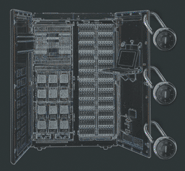Prescription For Medical Images
The medical imaging business is creating a storage boom as more hospitals embrace the practice of digitally storing patient records and test results, and new rules force them to keep that data longer, say VARs and vendors.
It's easy to see why. IBM estimates that medical images require 40 Mbytes of capacity for a single CAT scan and 60 Mbytes for a simple digital X-ray. These requirements balloon to 500 Mbytes for a multislice CAT scan and up to 3 Gbytes for a full-motion cardiac catheter video.

\
New regulats inspire new strategies for short-term and long-term storage of medical records.
Anderson Consulting Group, in a white paper sponsored by EMC, estimated that the health-care industry will purchase about $6 billion in storage next year, compared with $1 billion in 2001.
Then there is the sheer number of images to be saved. A large hospital can easily handle more than 100,000 patient exams in a year, each with the potential to generate multiple images, Cervenka said. The integration of storage to archive this data along with image management applications is critical, since health-care customers require that this image data be instantly available, he said. "In the past, with RAID, we could make any images stored for 60 [days] to 90 days available within five seconds," Cervenka said. "But now customers want images stored for a year in RAID available right away."
New regulations also require that images be stored for a longer period of time, Cervenka said. "We guarantee images are available according to requirements," he said. "For adults, they must be available for seven years. For children, they must be available for five years after their 21st birthday."
Solutions providing for storage of digital medical records are a fast-growing opportunity, said Blair Hankins, CTO of Ascendant Technology, an Austin, Texas-based provider of portals for midsize and large enterprises, including medical firms. Ascendant has yet to get into the storage space in a big way, but Hankins said that day is coming. "In a medical practice, we want our portal to stovepipe in all the needed data," he said. "We will be in storage big via our portal."
Anticipating this growth, vendors are offering multiple approaches to how medical images are stored and managed.
The traditional approach uses a hierarchical storage management system under which regularly accessed files are stored on high-speed hard-drive arrays and are gradually migrated to tape for long-term archival. This model has changed with the introduction of low-cost ATA-based drive arrays, where images can be stored cheaply with a slight increase in access time.
StorageTek recently added its BladeStore arrays, which puts five ATA hard drives on a Fibre Channel-connected blade, to its medical Picture Archiving Communication Systems (PACS) offerings, said Don Baune, manager of global practice vertical markets. BladeStore is managed under the company's Application Storage Manager software, which includes tools for migrating files from fast disk to BladeStore to tape, Baune said. The software can be adapted as needed, he said.
IBM also supports the traditional approach with its high-end Shark and midrange FAStT disk arrays and LTO tape libraries, said Kevin Leahy, director of marketing for emerging business opportunities at IBM.
A relatively new approach, called fixed-content storage, focuses specifically on the storage of digital objects that should not change over time. When an object is stored, a unique identifier is generated. That identifier is used to retrieve that object later without the user having to know where it is stored. EMC is offering such a capability, which it calls content-addressable storage, said John Mello, director of global health care. EMC is partnering with PACS application developers for storage solutions that combine a Clariion array for short-term, high-speed access with a Centera system on which images are archived for the long term.